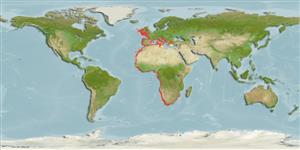Classification / Names
Common names from other countries
Main reference
Size / Weight / Age
Max length : 230 cm TL male/unsexed; (Ref. 11284); 202.0 cm TL (female)
Environment
Marine; demersal; depth range 30 - 600 m (Ref. 6808), usually 50 - 500 m (Ref. 26999)
Climate / Range
Subtropical, preferred ?; 56°N - 37°S, 19°W - 23°E
Distribution
Eastern Atlantic: Ireland and England southward round the Cape (South Africa) to central Mozambique (Ref. 5578), including western Mediterranean (to Tunisia and western Greece).
Countries | FAO areas | Ecosystems | Occurrences | Introductions
Short description
A giant skate with a broad-based, abruptly narrow-tipped snout covered with small, sharp thorns; pectoral disc angular, and no thorns on nape or back, but three rows of large thorns on tail (Ref. 5578). Larger immature and adult individuals grey with numerous small white spots above, underside white with no black pores; hatchlings plain reddish-brown above, often with blue spots, and white below with broad dusky grey margins on disc (Ref. 5578).
IUCN Red List Status (Ref. 115185)
Threat to humans
Traumatogenic (Ref. 5578)
Human uses
Fisheries: minor commercial; gamefish: yes
More information
ReferencesAquacultureAquaculture profileStrainsGeneticsAllele frequenciesHeritabilityDiseasesProcessingMass conversion
Tools
Special reports
Download XML
Internet sources
Estimates of some properties based on models
Phylogenetic diversity index
PD50 = 1.0000 many relatives (e.g. carps) 0.5 - 2.0 few relatives (e.g. lungfishes)
Trophic Level
4.4 ±0.83 se; Based on food items.
Resilience
Low, minimum population doubling time 4.5 - 14 years (Fec=55)
Vulnerability
Very high vulnerability (84 of 100)
Price category
